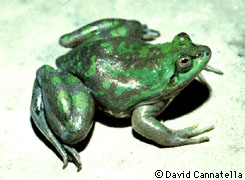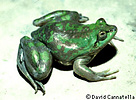Pseudidae
Paradox Frogs
David Cannatella


This tree diagram shows the relationships between several groups of organisms.
The root of the current tree connects the organisms featured in this tree to their containing group and the rest of the Tree of Life. The basal branching point in the tree represents the ancestor of the other groups in the tree. This ancestor diversified over time into several descendent subgroups, which are represented as internal nodes and terminal taxa to the right.

You can click on the root to travel down the Tree of Life all the way to the root of all Life, and you can click on the names of descendent subgroups to travel up the Tree of Life all the way to individual species.
For more information on ToL tree formatting, please see Interpreting the Tree or Classification. To learn more about phylogenetic trees, please visit our Phylogenetic Biology pages.
close boxIntroduction
The pseudids include two genera of aquatic frogs from The Magdalena Valley of Colombia and tropical lowlands of South America east of the Andes. Pseudis paradoxa is best known because its immense tadpoles (250-300 mm) metamorphose into relatively moderate-sized frogs. The two species of Lysapsus are much smaller than the two species of Pseudis.
Pseudids have an additional bony element in the fingers and toes between the penultimate and terminal phalanx. This element may increase the functional surface area of the highly webbed foot. Pseudis paradoxa float among vegetation in shallow ponds and roadside ditches, much like Rana catesbeiana in North America.
There are no fossils. Were it not for the distinctive intercalary elements, pseudids would be considered leptodactylids. The intercalary phalangeal elements are very different than those of arboreal frogs such as hylids and centrolenids.
Geographic Distribution
The distribution of living members of the family Pseudidae is indicated in red.

Discussion of Phylogenetic Relationships
Pseudidae was defined by Ford and Cannatella (1993) as the node-based name for the common ancestor of Lysapsus and Pseudis. Pseudids are generally characterized as having bony intercalary elements (Lynch, 1973), but Ford and Cannatella (1993) pointed out that these elements are distinctive in being elongate and perichondrially ossified. They considered these intercalary elements to be a synapomorphy of Pseudidae. The elongate nature of the intercalary element is unique among frogs, and suggests a role in increasing the length of the digit and area of the webbing in these highly aquatic frogs.
Lynch (1973) and Duellman and Trueb (1986:character J) used the presence of intercalary elements to unite Hylidae, Centrolenidae and Pseudidae into a clade. Intercalary elements are also known in Hyperoliidae and Rhacophoridae, as well as mantelline ranids and phrynomerine microhylids. The tree presented by Duellman and Trueb (1986:Fig. 17-3) has an equally parsimonious solution that would require convergent evolution of a firmisternal girdle (character C1) if lack of homoplasy in the intercalary element (character J1) is favored. In a subtree Duellman and Trueb (1986:Fig. 17-4) used the presence of intercalary elements to unite mantellines, hyperoliids, and rhacophorids, but not phrynomerines. This tree also has an equally parsimonious alternative that would unite phrynomerines with the aforementioned clade, but requires homoplasy in the Type 2 larva (character O2').
Ford's (1989b) study of dendrobatid relationships did not include centrolenids or pseudids. Ford and Cannatella continued the recognition of the clade consisting of Hylidae, Pseudidae, and Centrolenidae, which is diagnosed by the presence of intercalary elements., but did not name it. Hay et al. (1995) found that pseudids, hylids and centrolenids (each represented by one species) not to be a clade, although the latter two were sister-taxa, and all three were part of the Neobatrachia.
References
Click here for general list of references
Title Illustrations

Pseudis paradoxa, Bolivia; photo © 1995 David Cannatella
| Copyright |
© 1995 David Cannatella

|
|---|
About This Page
If you are interested in authoring or co-authoring the page for this taxon, or some part of it (even a species), contact David Cannatella.
David Cannatella

University of Texas, Austin, Texas, USA
Correspondence regarding this page should be directed to David Cannatella at
Page copyright © 1995 David Cannatella
 Page: Tree of Life
Pseudidae. Paradox Frogs.
Authored by
David Cannatella.
The TEXT of this page is licensed under the
Creative Commons Attribution License - Version 3.0. Note that images and other media
featured on this page are each governed by their own license, and they may or may not be available
for reuse. Click on an image or a media link to access the media data window, which provides the
relevant licensing information. For the general terms and conditions of ToL material reuse and
redistribution, please see the Tree of Life Copyright
Policies.
Page: Tree of Life
Pseudidae. Paradox Frogs.
Authored by
David Cannatella.
The TEXT of this page is licensed under the
Creative Commons Attribution License - Version 3.0. Note that images and other media
featured on this page are each governed by their own license, and they may or may not be available
for reuse. Click on an image or a media link to access the media data window, which provides the
relevant licensing information. For the general terms and conditions of ToL material reuse and
redistribution, please see the Tree of Life Copyright
Policies.
Citing this page:
Cannatella, David. 1995. Pseudidae. Paradox Frogs. Version 01 January 1995 (under construction). http://tolweb.org/Pseudidae/16951/1995.01.01 in The Tree of Life Web Project, http://tolweb.org/







 Go to quick links
Go to quick search
Go to navigation for this section of the ToL site
Go to detailed links for the ToL site
Go to quick links
Go to quick search
Go to navigation for this section of the ToL site
Go to detailed links for the ToL site